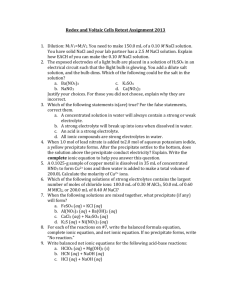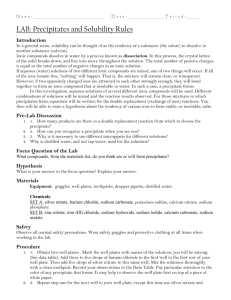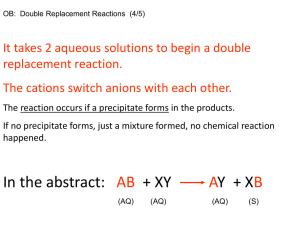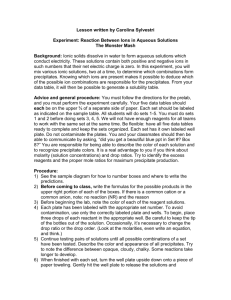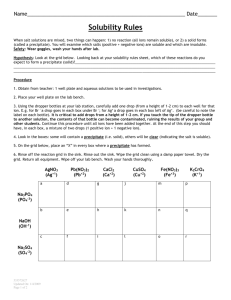ANSWERS: Precipitation - chemicalminds
advertisement
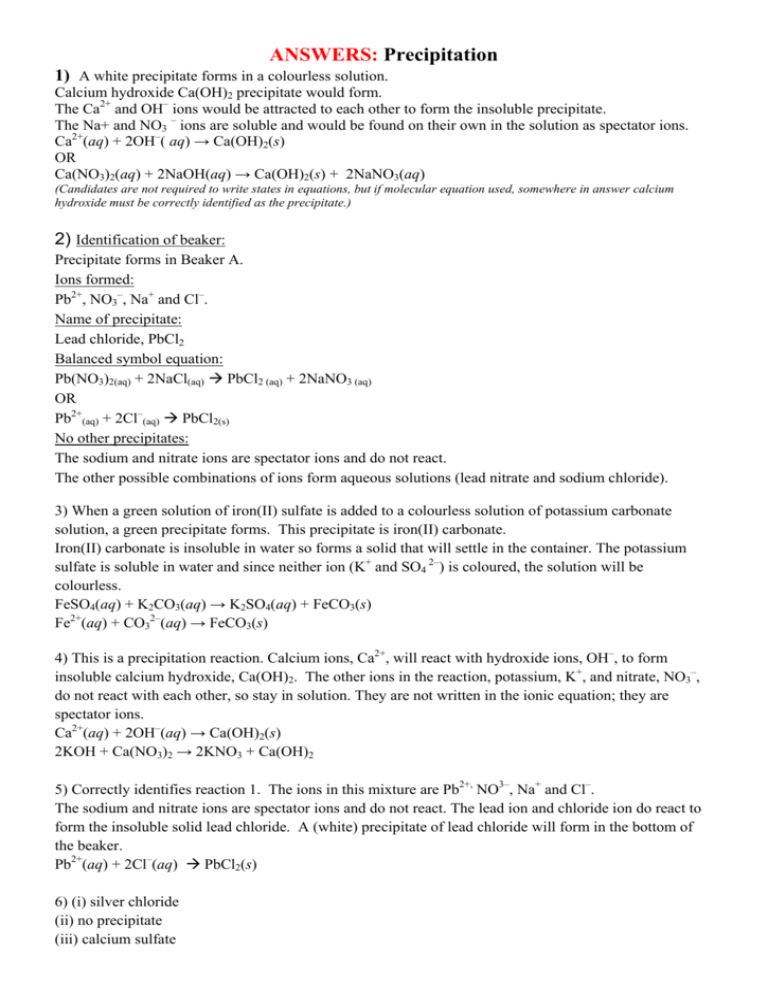
ANSWERS: Precipitation 1) A white precipitate forms in a colourless solution. Calcium hydroxide Ca(OH)2 precipitate would form. The Ca2+ and OH– ions would be attracted to each other to form the insoluble precipitate. The Na+ and NO3 – ions are soluble and would be found on their own in the solution as spectator ions. Ca2+(aq) + 2OH–( aq) → Ca(OH)2(s) OR Ca(NO3)2(aq) + 2NaOH(aq) → Ca(OH)2(s) + 2NaNO3(aq) (Candidates are not required to write states in equations, but if molecular equation used, somewhere in answer calcium hydroxide must be correctly identified as the precipitate.) 2) Identification of beaker: Precipitate forms in Beaker A. Ions formed: Pb2+, NO3–, Na+ and Cl–. Name of precipitate: Lead chloride, PbCl2 Balanced symbol equation: Pb(NO3)2(aq) + 2NaCl(aq) PbCl2 (aq) + 2NaNO3 (aq) OR Pb2+(aq) + 2Cl–(aq) PbCl2(s) No other precipitates: The sodium and nitrate ions are spectator ions and do not react. The other possible combinations of ions form aqueous solutions (lead nitrate and sodium chloride). 3) When a green solution of iron(II) sulfate is added to a colourless solution of potassium carbonate solution, a green precipitate forms. This precipitate is iron(II) carbonate. Iron(II) carbonate is insoluble in water so forms a solid that will settle in the container. The potassium sulfate is soluble in water and since neither ion (K+ and SO4 2–) is coloured, the solution will be colourless. FeSO4(aq) + K2CO3(aq) → K2SO4(aq) + FeCO3(s) Fe2+(aq) + CO32–(aq) → FeCO3(s) 4) This is a precipitation reaction. Calcium ions, Ca2+, will react with hydroxide ions, OH–, to form insoluble calcium hydroxide, Ca(OH)2. The other ions in the reaction, potassium, K+, and nitrate, NO3–, do not react with each other, so stay in solution. They are not written in the ionic equation; they are spectator ions. Ca2+(aq) + 2OH–(aq) → Ca(OH)2(s) 2KOH + Ca(NO3)2 → 2KNO3 + Ca(OH)2 5) Correctly identifies reaction 1. The ions in this mixture are Pb2+, NO3–, Na+ and Cl–. The sodium and nitrate ions are spectator ions and do not react. The lead ion and chloride ion do react to form the insoluble solid lead chloride. A (white) precipitate of lead chloride will form in the bottom of the beaker. Pb2+(aq) + 2Cl–(aq) PbCl2(s) 6) (i) silver chloride (ii) no precipitate (iii) calcium sulfate 2AgNO3(aq) + CaCl2(aq) 2AgCl(s) + Ca(NO3)2(aq) OR Ag+(aq) + Cl–(aq) AgCl(s) Ca(NO3)2(aq) + Na2SO4(aq) CaSO4(s) + 2NaNO3(aq) OR Ca2+(aq) + SO42–(aq) CaSO4(s) 7) lead nitrate + potassium chloride lead chloride and potassium nitrate 8) Precipitation. (do not accept the abbreviation ppt) Each solution contains 2 aqueous ions. Barium nitrate contains Ba2+ and NO3–, which are both colourless in solution. Iron(II) sulfate contains Fe2+, which is green in solution and SO42–, which is colourless in solution. Ba2+ and SO42– react to form an insoluble compound, barium sulfate, BaSO4. This forms a white deposit (precipitate) at the bottom of the beaker. Ba2+(aq) + SO42–(aq) BaSO4(s) OR Ba(NO3)2 (aq) + FeSO4 (aq) BaSO4 (s) + Fe(NO3)2 (aq) Fe2+ and NO3– remain in solution. They do not react. The Fe2+ ions give the solution its pale green colour. 9) (i) no precipitate (ii) lead chloride (iii) magnesium hydroxide Pb(NO3)2(aq) + 2KCl(aq) 2KNO3(aq) + PbCl2(s) OR Pb2+(aq) + 2Cl–(aq) PbCl2(s) OR 2KOH(aq) + MgSO4(aq) K2SO4(aq) + Mg(OH)2(s) OR Mg2+(aq) + 2OH–(aq) Mg(OH)2(s) 10) (i) Calcium sulfate (ii) Copper hydroxide (iii) No precipitate Ca2+(aq) + SO42–(aq) → CaSO4(s) Cu2+(aq) + 2OH–(aq) → Cu(OH)2(s) OR Ca(NO3)2(aq) + Na2SO4 (aq) → CaSO4(s) + 2NaNO3(aq) CuCl2(aq) + 2KOH(aq) → Cu(OH)2(s) + 2KCl(aq) 11) calcium sulfate, lead chloride, zinc carbonate 12) CaCl2 (aq) + Na2SO4 (aq) → CaSO4 (s) + 2NaCl (aq) Cu(NO3)2 (aq) + 2NaOH (aq) → Cu(OH)2 (s) + 2NaNO3 (aq) 13) A red brown /orange precipitate would form. The orange solution becomes colourless. Fe3+(aq) + 3OH–(aq) → Fe(OH)3(s) or FeCl3(aq) + 3NaOH(aq) → Fe(OH)3(s) + 3NaCl(aq) © 2012 http://www.chemicalminds.wikispaces.com NCEA questions and answers reproduced with permission from NZQA


